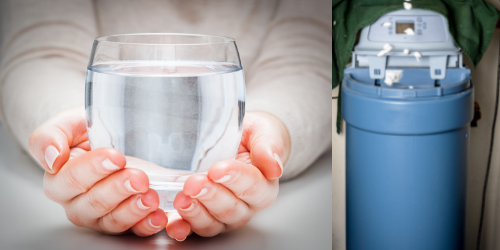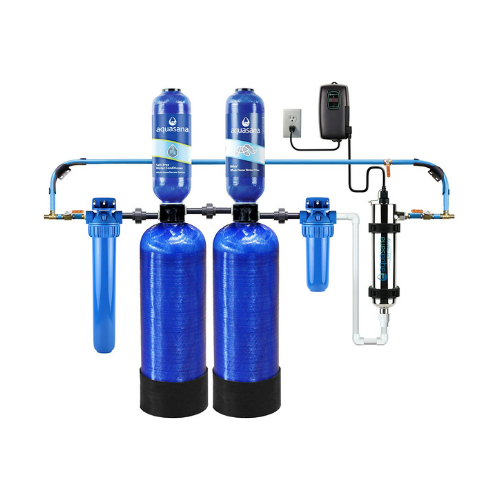Can you drink water from a water softener
Last updated on: May 1, 2024.
Drinking water is essential to our lives. When it comes to drinking water, we take all possible measures to ensure that we get only the safest water available.
Unfortunately, hard water contains minerals that don’t get absorbed into our bodies easily.
Therefore, we remove the hardness by using a high-quality water softener that can provide a regular supply of softened and safe water.
There has been some debate on how safe it is to drink softened water. To clearly understand the level of safety available in hard and softened water, we need to understand the difference between the two.
Hard water contains calcium and magnesium, and other minerals. With the help of the right water softener, hard water can be softened.
However, water softeners use sodium ions for the exchange process where the minerals get exchanged with the sodium ions. It could mean that there is a higher level of sodium in the softened water.
Hard water, by nature, affects the plumbing, household appliances, and kitchenware by leaving soapy scum or white spots. These minerals also accumulate in the pipes and damage the appliances that use water, such as a washing machine.
Moreover, they leave the skin feeling sticky as the hard water does not remove soapiness entirely. Hard water is also not great for hair as it makes it dry. For these reasons and more, we use water softeners.
Is drinking softened water healthy?

Drinking softened water is healthy, although it depends on a few factors. It also depends on the type of water softener you use. Most people can drink softened water with no negative impact.
Soft water may taste a little different at first. If you’re used to the taste of hard water, it may take some time to get used to softened water. People with skin conditions such as eczema find significant improvement when they switch to hard water for washing.
However, people who are restricted to a low-sodium diet for health reasons may be getting more sodium from softened water. Too much sodium may not be good for babies or for those having cardiovascular issues.
Water softeners that maintain acceptable levels of calcium and magnesium in hard water are safer water treatment systems. These systems ensure that minerals in hard water are not completely removed.
Fortunately, even if it did, there are alternatives that can help bring us calcium and magnesium, and other essential minerals, through our diet or supplements.
It is not necessary to depend on water to give our bodies the minerals we need.
Do water softeners add sodium to drinking water?

Ion exchange salt-based water softeners replace hardness with sodium. Water softeners use a process that involves ion exchange to remove minerals like calcium and magnesium, which make the water hard.
The media in the mineral tank is charged with sodium ions to replace the hard minerals. The resin beads that trap the minerals get cleansed with sodium. How much sodium gets added to the water will depend on the hardness levels of your water.
What are the effects of drinking softened water?
It is recommended that you don’t give softened water to Infants under six weeks because of the sodium levels as their kidneys are still developing. Softened water may cause babies to get dehydrated. Also, adults under doctor’s orders to restrict their salt intake may be better off without softened water.
Other than these two health concerns, there are no known side effects to drinking softened water. It is more of a personal choice. You may prefer the taste of hard water, while others get used to the taste of softened water.
Distilled Water Vs. Soft Water
It is very common to wonder if distilled water or softened water is better. The first step to choosing either will be to analyze the current water supply in your homes.
Decisions about improving water quality through water treatment systems must be based on the present water quality. There are three types of water – distilled water, filtered water, and softened water.
The filtration process and use vary among the three types.
Distilled water
It is considered pure and safe to drink. The water is boiled out of the contaminants making it pure and clean. However, distilled water is mainly used in machinery and batteries because it doesn’t leave any mineral buildup, even though it is safe to drink in spite of lacking some of the essential minerals.
Filtered water
Water that is filtered is safe to drink as it retains the oxygen in the water. The filtration process involves reverse osmosis. This process can be in whole-home water softeners and point-of-use systems. Filtered water is usually considered best for drinking.
Softened water
Softened water is preferred for washing and bathing, as well as for plumbing and household appliances. The filtration process used by water softeners includes replacing the hard minerals with sodium.
However, it is safe to drink, although people consider using soft water for household use such as laundry, cleaning, and appliances. It is best to recognize that the upfront cost of installing a water softener may be a tad high.
How do you make softened water drinkable?
If the hardness levels of your water are high and you want to reduce the amount of sodium intake, you may prefer to make the softened water drinkable by using a reverse-osmosis filter. It uses a purification technology with the help of a semi-permeable membrane to remove the salt and larger particles from the drinking water. You can get tasty and safe water that is free from chemicals and sodium.
Frequently Asked Questions:
Is it better to drink hard water or soft water?
You can drink hard or soft water without any adverse effects. Higher sodium levels generated by a water softener may pose a problem for those that are restricted to low-sodium diets.
However, there is a difference in taste. If you have been drinking hard water, you may need some time to get used to drinking soft water.
Does softened water taste salty?
Softened water does not taste salty. The sodium ion exchange works on the resin bed in the regeneration process and doesn’t get into the water supply.
Can babies drink softened water?
Babies under six weeks are too young for softened water because their kidneys are still developing. So, it is recommended that softened water is not used in mixing their feed as the sodium may be too hard. Softened water may only be considered safe for babies if the sodium concentration is below 200 mg/ L.
Does Soft Water Contain Sodium?
Water that is naturally soft already contains anywhere between 10 and 50 ppm of sodium. According to the Drinking Water Inspectorate (DWI), water with a sodium level of up to 200 ppm is safe for drinking purposes.
If the water is very hard, the water softener may need more water softener salts to soften the water. Generally, it is rare for sodium levels to exceed 220 ppm.
How do you remove sodium from softened water?
You can remove sodium from the softened water by using the reverse osmosis process. It is a natural and effective method for removing sodium from the water and also for reducing other contaminants.
What are the environmental impacts of home softening?
When a salt-based ion-exchange water softener is used, it discharges chloride into the septic systems. This chloride seeps into the groundwater and pollutes it, especially from the on-site septic system. Chloride also affects the environment through the wastewater treatment systems.
What is the Problem with Hard Water?
Hard water causes scale buildup in the plumbing and in household appliances, eventually decreasing the lifespan of washing machines, dishwashers, and other appliances that regularly use water.
Another problem with hard water is that it leaves your skin feeling sticky and your hair lustreless.
Can you use softened water in a kettle?
You can use softened water in your kettle and avoid limescale completely. Hard water tends to leave a limescale residue in our kettles over time, making it difficult to clean. Cleaning a kettle that has a limescale buildup can be a lengthy process involving lemon or vinegar. You would be better off using softened water in your kettle.
It also improves the taste of the water we use in the kettle. Soft water makes tea and coffee taste better, without any strong taste of hard minerals. Moreover, softened water improves the lifespan of all kitchenware and household appliances.
Conclusion
We have considered the difference between hard and soft water and the effect either one has on our health. While the safest drinking water is when it is processed through reverse osmosis, it is safe to drink water after it has been softened through the ion exchange process. The sodium exchanged for the minerals in the resin bed does not enter the water and make it salty or unsafe.
What’s more, the sodium level rarely exceeds 200 ppm, which according to DWI, is safe for consumption. Softened water also can be put through reverse osmosis, thereby reducing the sodium levels further.
About The Author

Judith— a passionate water treatment specialist — is a waste water management enthusiast, clean drinking water advocate, and someone with deep personal experience and knowledge about various water equipments. Her work was mentioned in countless notable water associations. Previously she was an editor at Water Alliance.

